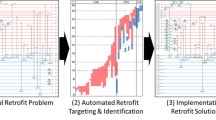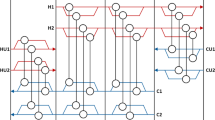Abstract
Research on the optimal design of heat exchanger networks (HENs) has primarily revolved around trading off technical design requirements for aspects of economy, such as capital cost of heat exchangers and utilities. As a result, considerations for safety, operability, and flexibility have received much less attention. This study presents a Pinch Analysis-based methodology that considers the inherent safety and operability aspects of an optimal HEN design. The procedure begins with data extraction, followed by utility targeting that gives due consideration to how each process stream impacts the inherent safety of the HEN. This is made possible via the use of a hot and cold Stream Temperature versus Enthalpy Plot (STEP) that prioritises the inherent safety index (ISI) on top of the heat capacity flow rate (CPs) during simultaneous targeting and design of the HEN. The Pinch temperatures and minimum utilities were determined using STEP. At the same time, the hot and cold stream pairs with higher ISIs and those with lower ISIs were matched together so that safety considerations could be emphasised and precautions taken with a particular heat exchanger. The disturbance propagation path through the HEN and the affected streams were also analysed. Network modification was performed using the downstream path concept in order to reduce disturbance propagation downstream of the HEN. The ∆T min violations and energy penalties from network changes were assessed. Flexibility and structural controllability of each network option were compared. The highest percentage of change in every stream of the network indicates that network is the most flexible, while the index of structural controllability closest to 1 demonstrates that the network is most controllable. Application of this method within an illustrative case study showed that network 3 was the most flexible as it yielded the highest percentage of change at 22 %. It was also the most controllable as it had a controllability index closest to 1.0, i.e. at 0.917.









Similar content being viewed by others
Abbreviations
- T c :
-
Cold stream temperature (°C)
- T h :
-
Hot stream temperature (°C)
- T′c :
-
Shifted cold temperature (°C)
- T′h :
-
Shifted hot temperature (°C)
References
Akpomiemie MO, Smith R (2016) Retrofit of heat exchanger networks with heat transfer enhancement based on an area ratio approach. Appl Energy 165:22–35
Bakar SA, Hamid MKA, Alwi SW, Manan ZA (2012) Development of a new model-based integrated process design and control for heat exchanger networks. In The 26th Symposium of Malaysian Chemical Engineers
Bakar SHA, Hamid MKA, Alwi SRW, Manan ZA (2013) Flexible and operable heat exchanger networks. Chem Eng 32:1297–1302
Bakar SHA, Hamid MKA, Alwi SRW, Manan ZA (2014) Design target selection for heat exchanger network synthesis based on trade-off plot. Energy Procedia 61:2621–2624
Calandranis J, Stephanopoulos G (1988) A structural approach to the design of control systems in heat exchanger networks. Comput Chem Eng 12(7):651–669
Chan I, Alwi SRW, Hassim MH, Manan ZA, Klemeš JJ (2014) Heat exchanger network design considering inherent safety. Energy Procedia 61:2469–2473
Čuček L, Klemeš JJ, Varbanov PS, Kravanja Z (2015) Significance of environmental footprints for evaluating sustainability and security of development. Clean Technol Environ Policy 17(8):1–17
Diwekar U, Shastri Y (2011) Design for environment: a state-of-the-art review. Clean Technol Environ Policy 13(2):227–240
Energy C (2003) Pinch analysis: for the efficient use of energy, water and hydrogen. Natural Resource Canada, Varennes
Escobar M, Trierweiler JO, Grossmann IE (2013) Simultaneous synthesis of heat exchanger networks with operability considerations: flexibility and controllability. Comput Chem Eng 55:158–180
Heikkilä AM (1999) Inherent safety in process plant design: an index-based approach. VTT Technical Research Centre of Finland, Espoo
Huang YL, Fan LTD (1992) Distributed strategy for integration of process design and control: a knowledge engineering approach to the incorporation of controllability into exchanger network synthesis. Comput Chem Eng 16(5):496–522
Jia C, Li Z, Wang F, Foo DCY, Qian Y (2015) A new graphical representation of water footprint pinch analysis for chemical processes. Clean Technol Environ Policy 17(7):1987–1995
Kim M, Pyo S, Lee S, Ghorbannezhad P, Foo DCY, Yoo C (2015) Greenhouse emission pinch analysis (GEPA) for evaluation of emission reduction strategies. Clean Technol Environ Policy. doi:10.1007/s10098-015-1063-1
Klemeš JJ (ed) (2013) Handbook of process integration (PI): minimisation of energy and water use, waste and emissions. Woodhead/Elsevier, Cambridge. ISBN 987-0-85709-0
Klemeš JJ, Kravanja Z (2013) Forty years of heat integration: pinch analysis (PA) and mathematical programming (MP). Curr Opin Chem Eng 2(4):461–474
Klemeš J, Varbanov P (2010) Process integration—successful implementation and possible pitfalls. Chem Eng Trans 21:1369–1374. doi:10.3303/CET1021229
Klemeš JJ, Varbanov PS, Wan Alwi SR, Abdul Manan Z (2014) Process integration and intensification: saving energy, water and resources. Series: De Gruyter textbook. De Gruyter, Berlin
Liew PY, Alwi SRW, Manan ZA, Klemeš JJ, Varbanov PS (2015) Incorporating district cooling system in Total Site Heat Integration. Chem Eng Trans 45:19–24. doi:10.3303/CET1335003
Linnhoff B, Flower JR (1978) Synthesis of heat exchanger networks: I. Systematic generation of energy optimal networks. AIChE J 24(4):633–642
Linnhoff B, Hindmarsh E (1983) The pinch design method for heat exchanger networks. Chem Eng Sci 38(5):745–763
Linnhoff B, Kotjabasakis E (1986) Downstream paths for operable process design. Chem Eng Prog 82(5):23–28
Linnhoff B, Townsend DW, Boland D, Hewitt GF, Thomas BEA, Guy AR, Marshland RH (1982) User guide on process integration for the efficient use of energy, 1st edn. IChemE, Rugby
Nawi WNRM, Alwi SRW, Manan ZA, Klemeš JJ (2015) A new algebraic pinch analysis tool for optimising CO2 capture, utilisation and storage. Chemical Eng Trans 45:265–270
Nawi WNRM, Alwi SRW, Manan ZA, Klemeš JJ (2016) Pinch analysis targeting for CO2 total site planning. Clean Technol Environ Policy. doi: 10.1007/s10098-016-1154-7
Pintarič ZN, Kravanja Z (2015) A methodology for the synthesis of heat exchanger networks having large numbers of uncertain parameters. Energy 92(3):373–382
Sakizlis, V, Perkins JD, Pistikopoulos EN (2004) Recent advances in optimization-based simultaneous process and control design. Comput Chem Eng 28(10):2069–2086. doi:10.1016/j.compchemeng.2004.03.018
Seferlis P, Georgiadis MC (2004) The integration of process design and control. Computer Aided Chemical Engineering, Amsterdam, the Netherlands
Shenoy UV (1995) Heat exchanger network synthesis: process optimization by energy and resource analysis. Gulf Professional Publishing, Houston, USA
Sikos L, Klemeš J (2010) Evaluation and assessment of reliability and availability software for securing an uninterrupted energy supply. Clean Technol Environ Policy 12(2):137–146
Tellez R, Svrcek WY, Young BR (2006) Controllability of heat exchanger networks. Heat Transf Eng 27(6):38–49
Wagialla KM (2012) Pinch-based and disjunctive optimization for process integration of wastewater interception with mass and property constraints. Clean Technol Environ Policy 14(4):597–608
Wan Alwi SR, Manan ZA (2006) SHARPS: a new cost-screening technique to attain cost-effective minimum water utilisation network. AIChE J 11(52):3981–3988
Wan Alwi SR, Manan ZA (2010) STEP: a new graphical tool for simultaneous targeting and design of a heat exchanger network. Chem Eng J 162(1):106–121
Wan Alwi SR, Ong ST, Mohammad Rozali NE, Manan ZA, Klemeš JJ (2013) New graphical tools for process changes via load shifting for hybrid power systems based on Power Pinch Analysis. Clean Technol Environ Policy 15(3):459–472
Westphalen DL, Young BR, Svrcek WY (2003) A controllability index for heat exchanger networks. Ind Eng Chem Res 42(20):4659–4667
Verheyen W, Zhang N (2006) Design of flexible heat exchanger network for multi-period operation. Chem Eng Sci 61(23):7730–7753
Zunlong J, Wang D, Wei X, Wang Y (2015) Analysis of heat exchanger network for temperature fluctuation. Adv Mech Eng 7(9):1–7
Acknowledgments
The authors would like to thank the Ministry of Higher Education Malaysia and Universiti Teknologi Malaysia for providing the research funds for this project under Vote Nos. J130000.3009.00M77 and Q.J130000.2409.03G40. Support from the Faculty of Information Technology and Bionics, Pázmány Péter Catholic University in Budapest is also gratefully acknowledged.
Author information
Authors and Affiliations
Corresponding author
Rights and permissions
About this article
Cite this article
Hafizan, A.M., Wan Alwi, S.R., Manan, Z.A. et al. Optimal heat exchanger network synthesis with operability and safety considerations. Clean Techn Environ Policy 18, 2381–2400 (2016). https://doi.org/10.1007/s10098-016-1222-z
Received:
Accepted:
Published:
Issue Date:
DOI: https://doi.org/10.1007/s10098-016-1222-z




